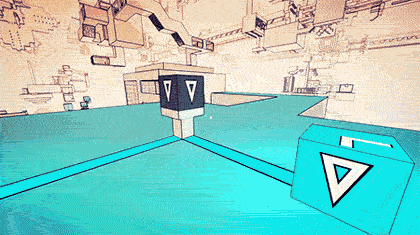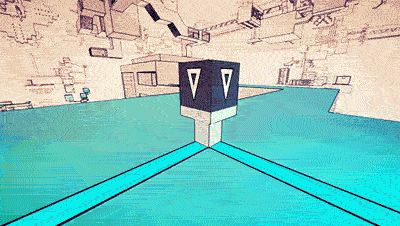In this update, I’m going to talk about this new mechanic that I’ve added to Manifold Garden, at the moment known as “invert mode”. It’s still a work-in-progress, but I’ll be discussing its origin and its current state.
Origin
Earlier in December, Ryan Clark (the developer of Crypt of the Necrodancer) started doing a series of streams in which he analyzes an indie game’s “market potential”, using methods he’s developed over the years. Ryan wrote about his process in this gamasutra blog post: “What Makes an Indie Hit?: How to Choose the Right Design”,
I found the article really informative, and had actually wanted to ask Ryan about Manifold Garden. So when I heard that Ryan was looking to start streaming this process with games currently in development, I immediately jumped at the opportunity. I guess I jumped pretty quickly, because Manifold Garden ended up being the first game to be looked at.
Here’s the Twitch archive of the stream: http://www.twitch.tv/ryan_clark/v/29451504
Here’s the chart of the analysis at the end of the stream (click on image for larger version):
s you can see, there are several factors that Ryan uses to get an estimate of a game’s market potential. The biggest thing I took away from the conversation was that Manifold Garden had low “post-play virality”. This isn’t to say that the game isn’t good. What it was, was that a lot of what was exciting about the game, the architecture, the geometry, they were all shown in the trailer or in the description of the game. Those were in the “pre-play virality”.
I realized I needed more of these “wow” moments in the game, that makes people want to remark and tell others.
If you look at the chart, you can see that Starseed Pilgrim has low pre-play virality ( 0.8 ), but very high post-play virality ( 1.3 ). Keep in mind that these numbers are super hand wavey, but it’s more about their relation to the other numbers. Plus, there were discussions within the chat about them as well.
Starseed Pilgrim has low pre-play virality because the art style didn’t stand out, and the trailer didn’t really do a good job of conveying what you did in the game. It was hard to see what was special about the game without playing it. This was actually quite consistent with my initial impression of the game.
However, Starseed Pilgrim has very high post-play virality because a lot of people who played it saw its brilliance, and would go on to tell others about it. This is largely because what makes Starseed Pilgrim special is the way the game makes you explore, and the intricate dance it does with its systems. These are not things that you can derive before playing the game, only after having played it.
I started to think about how I can improve the design of Manifold Garden to have more special moments like in Starseed Pilgrim that encourages post-play virality.
The other takeaway was comparison to Antichamber. Now, if you’ve been reading this blog, you’ll know that I know this already. Comparisons to Antichamber is inevitable – both games draw inspiration from Escher, are puzzle games of the mind-bending variety, and have minimalist art styles with edge detection. I don’t think being compared to Antichamber is necessarily bad, and is certainly much better than being generic and being compared to Portal… However, it’s more from a personal artistic standpoint. I’m not trying to make a bad Antichamber clone and don’t want to come across as that. How can my visual stand out from Antichamber even more?
Invert Mode
Invert mode started as a purely visual experiment. However, it looked quite cool, so I thought it’d be worth exploring it as a mechanic to fit within the game.
Here’s the first tweet I posted about it:
The visuals:
As you can see, the visual was quite rough. Pretty much all I did was invert the colors in the edge detection shader. At the time, I was still keeping the fog color to white, so things further in the distance faded to white as a result. There’s also no color fade in the lines – they’re white all throughout, so they do not create a sense of depth.
This also resulted in a very sudden “pop-in” effect when the world wrapping happened. This is very clearly seen in the picture below. Note how the geometry in the distance just cuts off suddenly:
Eventually, I rewrote the edge detection shader so that I was able to change the color of the edges and choose whether to have the lines fade to black or white in the distance. I also realized that by changing the fog color to black, I can get a really nice fade in the distance.
What do you actually do in invert mode?
The first thought of a mechanic that could work well in invert mode is taking away the ability to change gravity.
I was thinking of the way Starseed Pilgrim and Ridiculous Fishing are designed, in which the player goes through the same level, but experiencing it completely differently. In Starseed Pilgrim, when you go into invert mode, the platform becomes space, and space becomes platform. In Ridiculous Fishing, first you go down, avoiding all the fish, then you go up, and try to catch as much fish as you can.
To me, this is a really interesting idea, as it gets the player to think with duality during the first stage of the game.
Richard Terrell coins this kind of level design Folded Level Design, which I think works very well.
Removing the ability to change gravity seems to be part of this, because now the player has to navigate through the same level, but experience the architecture differently. Now a wall is no longer a path, but an actual barrier.
I was also thinking about other ways in which the theme of “inversion” could work. One way I thought was to reverse the puzzle path flow.
In normal mode, you can grow trees from boxes. These trees then grow more boxes, which you can pick off and place on buttons to trigger various things.
So in invert mode, you’d take a box off a button (which you’d have to turn on first), and then bring to a tree (a special invert tree):
Some other ideas here:
you have to pick up the special invert box to enter into invert mode. Dropping it brings you back to normal mode and resets your position. The reset to normal mode is not instantaneous – instead, there is a fade to white. When the fade is complete, you’re back to normal mode. However, this means that while it’s still fading, you can pick up the box again, and it’ll cancel the fade and keep you in invert mode:
I was also thinking the trees could have the same effect? So if you walked up to a tree, it would also cancel the return to normal mode, allowing you to extend your time in invert mode longer without carrying the invert cube. Not exactly sure what you’d do with this though:
I also spoke with Chris Bell, one of the designers on Journey, about this, and Chris has some issues with it. I will put that on the next post as this is getting quite long.













